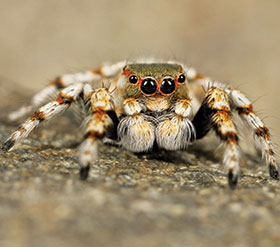

A big, hairy spider skitters across the floor, its eight long legs moving jerkily and almost robotically and you have the creeps. Spiders give us the willies and our arachnophobia stems from how they move their angular, jointed legs.
A big, hairy spider skitters across the floor, its eight long legs moving jerkily and almost robotically and you have the creeps. Spiders give us the willies and our arachnophobia stems from how they move their angular, jointed legs.
Spiders move in this unnatural, mechanical fashion because arachnid locomotion makes use of a unique hybrid propulsion system involving hydraulics. While they have muscles to flex their spindly limbs inward, they use hydraulic pressure to extend them outward. Almost all other limbed animals have both flexor and extensor muscles, which produce smoother and less unsettling movements.
A spider’s body is filled with a fluid called haemolymph that is similar to blood. Spiders only have two body parts. The first is the fused head and middle, the cephalothorax. The other is the abdomen. All eight spider legs are attached to the cephalothorax. This is important, because outward leg movement is controlled through the cephalothorax.
This regulates the hydraulic movement and haemolymph pressure. The cephalothorax acts like a very finely-tuned, fluid-filled bellows that pushes haemolymph around the body of the spider in a fraction of a second. The flexor muscles in the spider’s legs naturally want to contract, but the hydraulic pressure allows the legs to move outward and resist this contraction.
Parry and Brown measured resting pressures of 6,6 kPa and transient pressures of up to 60 kPa in spider legs. An isolated leg could lift more weight as the pressure inside it was increased, and it was found that the spiders had a special mechanism to seal off a joint and prevent fatal depressurisation when a leg was ruptured.
The lack of flexors and extensors doesn’t prevent spiders from moving efficiently. Hydraulics also gives some spider species impressive jumping abilities. Jumping spiders can leap more than 50 times their own body length by swiftly boosting haemolymph pressure in their third and fourth limbs. When a spider gets ready to jump, it generates excess pressure of up to 60 kPa as the legs extend in order to accommodate more fluid.
Though hydraulics has its advantages, the fact that a spider is basically an hydraulic system gives rise to a critical vulnerability because it relies on hydrostatic pressure in its skeleton. If a spider’s cephalothorax is punctured or it loses a leg, movement will be severely inhibited as the system’s pressure drops sharply. Have you ever seen a dead spider with all eight legs curled up? This is because when the spider dies its legs naturally contract due to the flexor muscles lacking hydrostatic resistance. The hydraulic system has been taken completely offline, while the flexor muscles go into rigor mortis.
Unique and creative designs
There is some great technology that can be developed by mimicking spiders. Spiders can’t grow to be very big because the hydraulics and exoskeleton can’t support large objects. By considering the scaling principles of their hydraulic locomotive system, it may be possible to understand better the design criteria for small hydraulically driven machines or robots.
Different research groups have mimicked the hydraulic mechanism of spider biology to come up with creative designs and solutions for unique problems. Researchers have created a small robot made from a 3D printer that uses hydraulics and pneumatics to jump and crawl. Just like a real spider, the robot’s legs are controlled through hydraulic pumps in the abdomen of the machine. Cheap, lightweight robots could be used to search through rubble and debris in buildings quickly, send robot spiders into hostage situations, scout clogged drains and sewers, go into dangerous mines, or probe caves.
One heartwarming story is about a dad, Ben Ryan who, inspired by the way spiders move their legs, developed some revolutionary prosthetics technology for his young son, whose arm was amputated at 10 days. With the aid of advanced 3D printing techniques, the prosthetic uses fluid power to operate a lightweight grabbing mechanism, with no batteries or small parts which can be a risk to babies. Sacks of fluid in the socket are squashed by the user and this controls the grabbing mechanism. The device is cheaper and faster to produce than any other prosthetic on the market and could allow thousands more very young amputees the opportunity to have a prosthetic fitted in the crucial one to two year window of their life when their body is best able to accept one. Ben is currently looking to the crowdfunding website, Indiegogo to help his fledgling company, Ambionics take the prototype to market to help thousands of babies in the same position.
For more information visit https://tinyurl.com/j7ner3q
© Technews Publishing (Pty) Ltd | All Rights Reserved